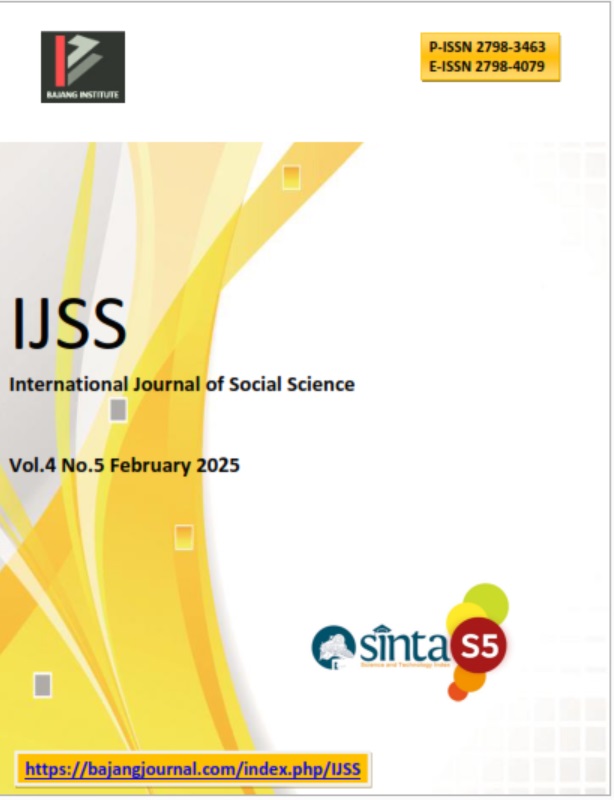GENDER INEQUALITY IN WOMEN LEADERSHIP OF PUBLIC SECTOR INSTITUTIONS IN PAPUA, INDONESIA
DOI:
https://doi.org/10.53625/ijss.v4i5.9707Keywords:
GENDER INEQUALITY, WOMEN LEADERSHIP, PUBLIC SECTOR, PAPUAAbstract
The gender inequality still exists in the workplace, where women face barriers to improving a higher career path. One of the barriers comes from the institutional environment in the form of gender gap, which make it increasingly difficult for women to reach leadership position. Gender stereotypes halt women’s career advancement, resulting in a glass ceiling phenomena. This study examines the effect of gender inequalities on career satisfaction towards Papuan women leadership during their employment among public institutions. Descriptive qualitative approach was used; the participants selected were female leaders in public institution including education, government, health, and libraries sector. Pattern across the study showed that women remain underrepresented in upper-level management position because they feel unfairly treated by the institution. Barriers generally outweigh opportunities for career advancement; these including glass ceiling phenomena in the workplace by asserting that men make better leaders. Consequently, more women are rising into leadership roles at all levels, including functional public service positions. Given these results, leaders need to build high quality relationship with employer and employee to prevent a glass ceiling in the workplace, resulting in promoting gender equity more broadly within the public whom they serve.
References
Aikman, S., Halai, A., Rubagiza, J. (2011). Conceptualising gender equality in research on education quality. Comparative Education, 47(1), 45-60. https://doi.org/10.1080/03050068.2011.541675
Ayton, D. (2023). Qualitative descriptive research. Qualitative Research–a practical guide for health and social care researchers and practitioners.
BPS Statistics Indonesia (2023). Factors affecting women’s need to work in Papua. BPS Provinsi Papua. Retrieved from https://papua.bps.go.id/en/publication/2023/07/10/6084f4e63e5537e392b2a119/faktor-faktor-yang-mempengaruhi-keputuhan-perempuan-bekerja-di-papua.html
BPS Statistics Indonesia (2024). Illiteracy Rate by Province and Age Group. Retrieved from https://www.bps.go.id/en/statistics-table/2/MTAyIzI=/illiteracy-rate-by-province-and-age-group.html
Chisholm-Burns, M. A., Spivey, C. A., Hagemann, T., & Josephson, M. A. (2017). Women in leadership and the bewildering glass ceiling. American Journal of Health-System Pharmacy, 74(5), 312-324.
Eagly, AH., Carli, LL. (2007). Women and the labyrinth of leadership. Harvard Business Review, 85(9), 62-71.
Evans, K., Maley, J. (2020). Barriers to women in senior leadership: How unconscious bias is holding back Australia’s economy. Asia Pacific Journal of Human Resources, 59(2), 204-226.
Fitriani, F., Tjilen, AP. (2019). Leadership Study of Women in Education in Merauke Regency. International Journal of Mechanical Engineering and Technology (IJMET), 10(3), 1820-1825.
Fitriani, Nebore. RD., Suradinata, PE. (2022). Papuan Women’s Participation In Political Leaders. Musamus Journal of Public Administration, 4(2), 46-56.
Furidha, B. W. (2023). Comprehension of the Descriptive Qualitative Research Method: A Critical Assessment of the Literature. Acitya Wisesa: Journal Of Multidisciplinary Research, 1-8.
Ginting, KR., Pancawati, G., Priyono, B. (2022). Empowering Women in Papua Province, Indonesia as Part of the Green Economy. The 3rd International Conference on Governance, Public Administration, and Social Science, 1148-1157.
Hendrarti, D. W. B., Lestari, K. W., Wardhani, N. F., & Thakare, B. R. (2024). Cracking the glass ceiling: The case of women’s empowerment in promoting village tourism development in Malang, Indonesia. Jurnal Ilmu Sosial Dan Ilmu Politik, 27(3), 330-344.
Jayachandran, S. (2015). The roots of gender inequality in developing countries. Annual Review of Economics, 7, 63-88.
Madsen, SR. (2015). Why do we need more women leaders in higher education? https://digitalcommons.usu.edu/cgi/viewcontent.cgi?article=1156&context=marketing_facpub(open in a new window).
Mashele, W., & Alagidede, YIP. (2022). The appropriate leadership styles in times of crisis: a study of women in senior leadership position in corporate South Africa. Gender in Management An International Journal, 37(4), 494-508. Retrieved from https://doi.org/10.1108/GM-02-2021-0031
Mollet, JA. (2011). The dynamics of contemporary local-government policies and economic development in West Papua. Development in Practice, 21(2), 232-243.
Offermann, LR., Foley, K. (2020). Is there a female leadership advantage? Business & Management. DOI: 10.1093/acrefore/9780190224851.013.61
Organization for Economic Cooperation and Development (OECD). (2022). Gender Equality of Women and Girls: DAC Guidance for Development Partners, OECD Publishing, Paris, https://doi.org/10.1787/0bddfa8f-en
Sandelowski, M. (2000). Whatever happened to qualitative description? Research in Nursing & Health, 23(4), 334-340. Retrieved from https://doi.org/10.1002/1098-240X(200008)23:4<334::AID-NUR9>3.0.CO;2-G
Shava, GN., Chasokela, D. (2020). Women in higher education leadership and parenthood, experiences from a university in Zimbabwe: So few women in leadership positions. The Educations Systems of Africa, 1-15.
Todaro, MP., Smith, SC. (2011). Pembangunan Ekonomi (11th Edition ed., Vol1). Jakarta: Erlangga.
Ulfa, M., Jamal, A., Shabri, M., Majid, A. (2020). Portrait of Gender Economic Inequality in Indonesia. East African Scholars Journal of Economics, Business and Management, 3(1), 79-85.
Wekke, IS., Ibrahim, I. (2019). Women Leadership on public institution of society of West Papua. PALASTREN, 12(2), 569-588.
Downloads
Published
How to Cite
Issue
Section
License
Copyright (c) 2025 Titia Erika Sarlota Awom, Maria Niester Insoraki Komboy

This work is licensed under a Creative Commons Attribution 4.0 International License.

















